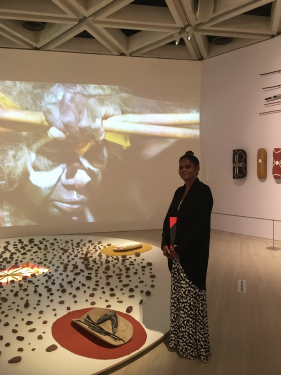
Waringarri Aboriginal Arts Wirnan (detail). Desert River Sea AGWA installation view, 2019. Photo by Rebecca Mansell.
As a group from Waringarri Aboriginal Arts in the East Kimberley, we are proud to present our Wirnan Project as part of the Desert River Sea: Portraits of the Kimberley exhibition.
“Wirnan” is a traditional Miriwoong word that describes the trade and exchange of gifts from one tribe to another. The trade of Wirnan is a way of keeping each of us connected through sharing and most importantly giving each other ideas and making artefacts. Collecting is connecting to our Country to know who we are and our children and how we used to communicate and talk and understand each other’s ways. To respect and understand our Country.
When we began this project, we had the privilege and permission to listen to one of our leaders (who has now passed) talking in Miriwoong language. She spoke about how the four Indigenous tribes came together to a special place, to trade their gifts at Argument Gap.

It took us a while to brainstorm and to draw what Wirnan meant to us. When our map of drawings was finished, we hung it up, sat back and looked at it. We saw that we had drawn similar pictures to express Wirnan of the old and the now. So, we decided to make four coolamons as it was the main artefact used for carrying all sorts of things. Two coolamons, made traditionally from wood and paperbark, to acknowledge our ancestors from the past that walked from different directions to trade their gifts such as spears, boomerangs, spearheads, dances, songs, corroboree, ochre and traditional marriages. And two more coolamons, made with steel and ceramic, to represent our present day with similar trades, but with gifts such as food, blankets, material and money. We laid out many rocks separated in four different colours to represent the tribal boundaries. One of our highlights was going out on Country to collect what we needed for our project, to make it bigger and better, more special and meaningful.
Our Wirnan project needed more to be done, so we added a projector to show video clips and photos old and new of our people and culture. We included artefacts that we’d made with wood and ceramic at our art centre and a fire to represent the traditional dance that took place to celebrate the coming together of the tribes.
Making the Wirnan project was a big challenge for our group, but in the end, we did it. There was heartache and emotions for the dedication of two of our leaders who had recently passed away and our inspiring group who had poured our hearts and soul into this project. We can now stand proud and say that we have accomplished our Wirnan project as one strong cultural group, reminding us of how our tribal groups came together as one big family those many, many years ago.
Thank you to everyone that has made the journey, travelling near, far and wide to the Art Gallery of WA on Noongar Country as one, to share our legacies, to exchange our stories and art in different mediums. Our Wirnan project is all about this, sharing, giving and exchanging.
Desert River Sea: Portraits of the Kimberley is showing at AGWA until 27 May 2019.
You may also like

Art connects family in a time of COVID-19
YAP member Grace Cole speaks to Pulse Perspectives artist Tayla Wetherall about her work Don’t you forget about me. Inspired by Tayla’s personal experience during Covid-19 it’s a piece that speaks of not forgetting family and your connections with them.



